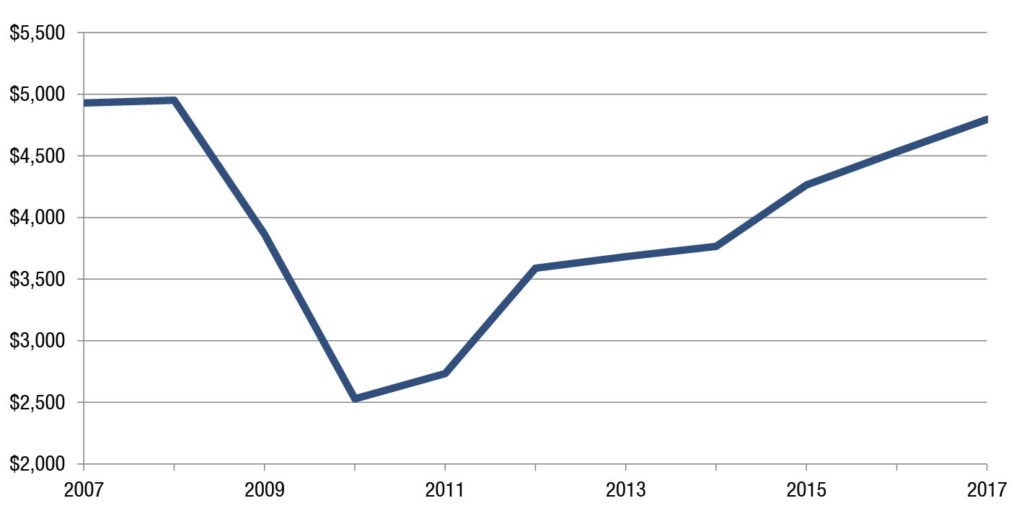Education Funding in Georgia: Years of Cuts Cast Long Shadow
Georgia is spending $11.6 billion on education in the 2017 fiscal year or about 51 percent of the state’s general fund budget. Spending on elementary and secondary education is $8.9 billion. The budget for the university system is $2.1 billion and is $350 million for technical colleges. The state’s 2017 budget allots the Georgia Student Finance Commission $91 million in non-lottery funds and $55.6 million to the Department of Early Care and Learning.
This constitutes a $640 million increase from 2016 and partially reverses years of deep cuts. This increase follows two years of modest bumps and reduces some of the financial pressure education leaders face but does not eliminate them.
Georgia ranks 38th in per-student funding for K-12 education, according to the U.S. Census Bureau, and is home to the fifth most students in poverty as measured by participation in the federal free and reduced lunch program. Georgia spends $1,800 less per student than the national average despite the fact increased funding is connected to higher achievement, particularly for low-income students. Gov. Nathan Deal convened a commission to examine K-12 funding in 2015 proposed a formula intended to more effectively distribute state dollars to school districts. Equally important is whether the money allocated is sufficient to meet students’ needs and the state’s workforce development goals. These figures suggest it is not.
The state’s investment in higher education diminished over time leading to tuition hikes that price postsecondary programs beyond the reach of many students and complete them. Enrollment in technical colleges is down and student loan debt is climbing. These challenges will continue given the growing percentage of low-income students in K-12, the feeder system for postsecondary schools.
Elementary and Secondary Education: K-12 Funding Formula Short $166 Million
Georgia’s public school students are getting $166 million less in the 2017 fiscal year than called for in the state’s funding formula. This is a smaller shortfall than in previous years, but districts continue to face fiscal constraints as they work to bring class sizes back down, restore discontinued programs, eliminate teacher furlough days and raise teachers’ salaries. The General Assembly underfunded schools every year since 2003, cutting more than $9 billion from its Quality Basic Education formula over 15 years.
Georgia’s 15 Years of Underfunding its Education Formula
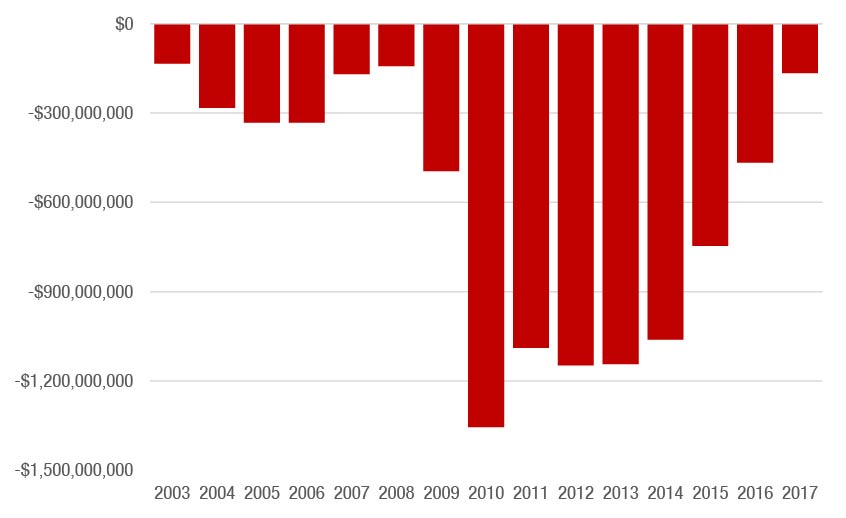
Elementary and Secondary Education: Restored Funding and Cost Shifting
State funding for K-12 schools is an inflation-adjusted 2.3 percent lower in 2017 than in 2002. This is an improvement compared to recent years, but even this progress does not keep pace with growing student poverty. The state is also shifting significant costs to school districts, which lessens the effect of the funding increases.
Students in poverty face barriers to educational success and require additional support and resources to meet the high academic standards the state has set for them. The percentage of Georgia’s students in poverty (based on participation in the federal free- and reduced-price lunch program) climbed from 44 percent to about 62 percent in 2016. Meanwhile, more local revenues pay for expenses the state once covered. Georgia stopped funding health insurance for school bus drivers and other school support staff in 2012. The monthly amount districts pay for health insurance for each of these workers soared to $846 in 2017 from $296 in 2012. State funding for student transportation also dropped. Georgia is spending about 22 percent less per student to bus them to and from school in 2017 than in 2002.
Funding Not Keeping Pace with Georgia Students’ Needs
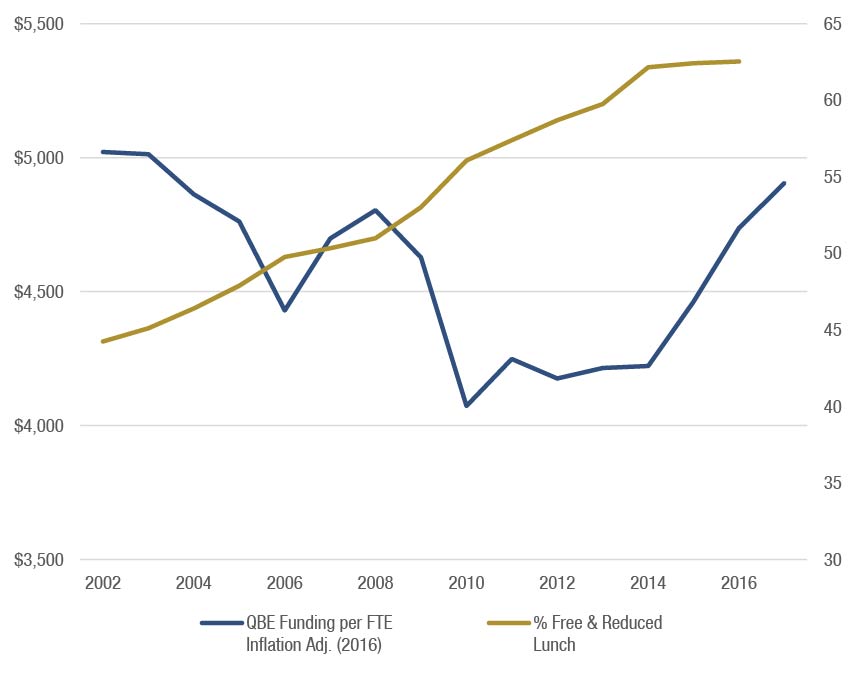
Lottery Funds: Support for Pre-K and College Students
Georgia expects to spend $1.07 billion in lottery revenue in the 2017 fiscal year on education programs:
- Helping Outstanding Pupils Educationally (HOPE) Scholarships are for high-achieving students pursuing a bachelor’s or associate’s degree. These funds include money for the Zell Miller Scholarship.
- HOPE grants are for students who maintain a 2.0 grade point average in a certificate or diploma program at a technical college. These funds include money for the Strategic Industries Workforce Development Grant and the Zell Miller Grant.
- HOPE GED grants are one-time awards to students who complete a GED and enroll in a postsecondary education program.
- Student Access Loans provide low-interest loans to college students.
- Georgia’s Pre-Kindergarten program is for four-year-olds to prepare for kindergarten.
Most Lottery Money Supports HOPE Programs
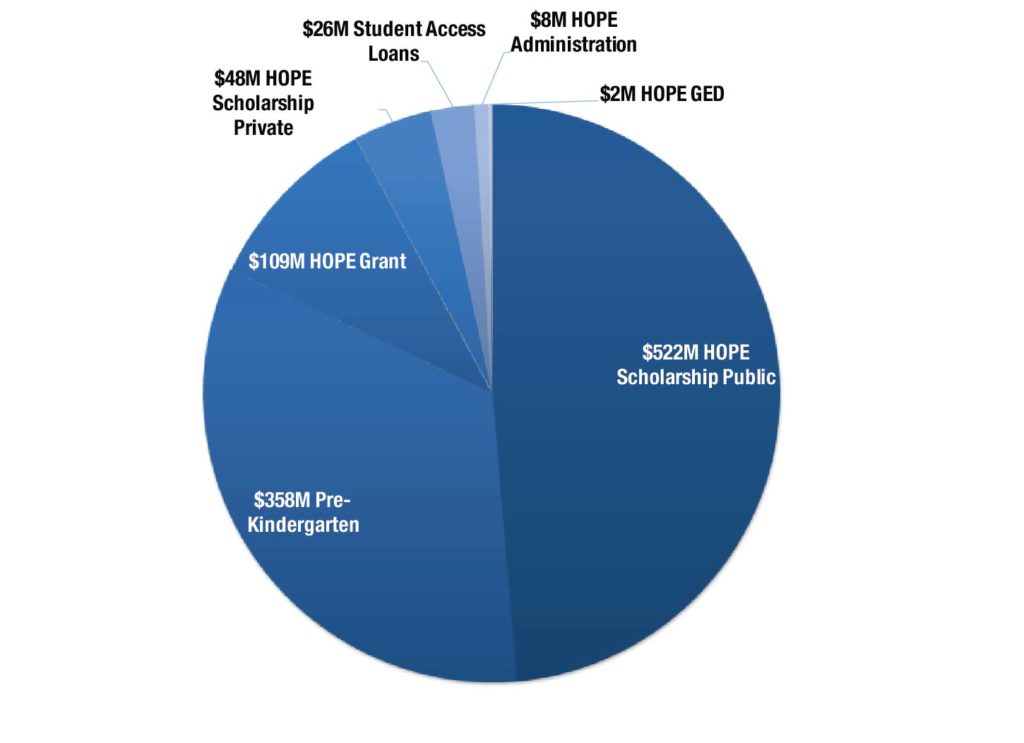
Pre-Kindergarten: A Step Forward but Quality Lags
Funding for the Pre-Kindergarten program in the 2017 fiscal year is up 11 percent over 2016. The added money is for pay raises for lead and assistant teachers, an important step to improve teacher retention. Despite this bump, funding has not returned to the pre-recession amount. Per student funding is nearly 9 percent below 2007, adjusted for inflation. Critical needs remain.
The program’s class size maximum of 22 students does not meet the quality standard recommended by the National Institute for Early Education Research. In addition, start-up money distributed by the state to help launch new Pre-K classes no longer reflects the actual costs incurred by program providers. The governor’s Education Reform Commission recommends lowering class sizes to 20 and increasing start-up funds to $12,000 from the current $8,000, in order to improve quality. The money is not budgeted in 2017 to implement these recommendations.
Per Student Pre-K Funding Trails Pre-Recession Levels

University System of Georgia: Less State Support, Tuition Hikes
State funding per full-time equivalent student in the university system in the 2017 fiscal year is an inflation-adjusted 50 percent less than Georgia invested in 2001. The decline in funding spurred tuition hikes and institutional mergers, most recently the announced combination of Albany State University and Darton State College.
The university system could deploy significantly more resources if the state maintained past levels of investment. If per-student funding in the 2017 fiscal year matched the 2007 level when adjusted for inflation, the state would send about $620 million more into the system, mitigating the need for large tuition increases. Even without adjusting for inflation, an estimated $268 million more would go to the system if the 2007 per-student funding level was applied this year.
More Students, Less State Funding
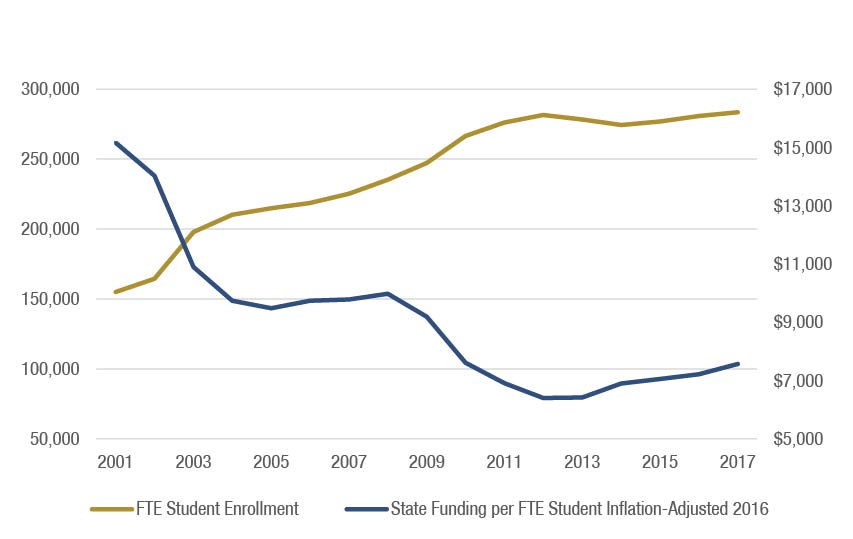
Diminishing College Affordability
College costs are squeezing Georgia’s students. Tuition is rising while state funding is shrinking. Families struggle to cover the increase as earnings do not go as far as a decade ago. More students are borrowing to pay for college and the debt they carry is climbing.
Georgia’s median household income was $49,555 in 2014, the most recent year of data from the U.S. Census Bureau, or nearly 11 percent lower than 2007 when adjusted for inflation. Average tuition across the university system rose an estimated 99 percent from 2007 to 2017, much more at some institutions. The yearly cost to attend many state four-year universities now tops $20,000, counting tuition, mandatory fees, room and board, books and supplies.
The state also made deep funding cuts to Georgia’s technical colleges in fiscal years 2009 and 2010 and tuition hikes followed. Tuition jumped 65 percent to $89 per credit hour in 2015 from $54 per credit hour in the 2009 fiscal year. Both postsecondary systems froze tuition levels for the 2016-2017 school year. This is the second consecutive year technical schools froze tuition rates.
Average Loan Debt for Georgia Graduates
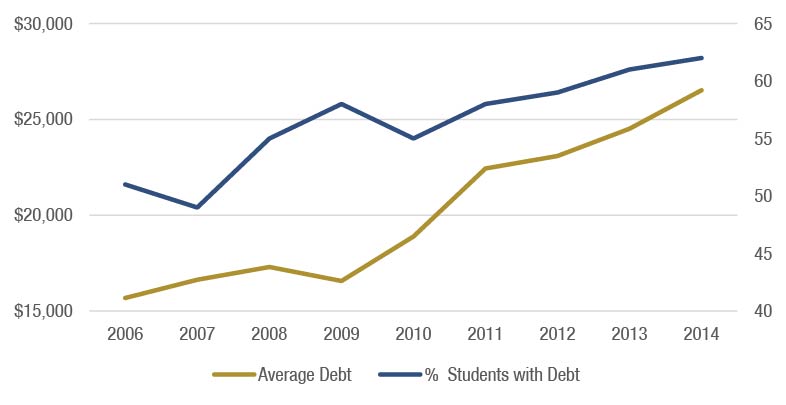
Technical College System of Georgia: State Funding Still Trails Pre-Recession Level
State spending per full-time equivalent student in the technical college system is nearly 3 percent below 2007 in inflation-adjusted dollars. This follows increases in recent years after plummeting recession-era, per-student funding. Much of the financial gain is due to declining enrollment. In 2015 student enrollment fell 35 percent compared to the 2011 peak.
Today’s technical college enrollment is nearly as low as 2007 and it appears it will continue to slide. Student enrollment in fall 2015 declined 4.4 percent system-wide from fall 2014. Lack of affordability is one reason. More than 58 percent of technical college students are considered low-income based on participation in the federal Pell Grant program. These students can struggle with increasing costs paired with reductions in the HOPE Grant award. They may take fewer classes or drop out.
Per Student Funding Lags Pre-Recession Level
